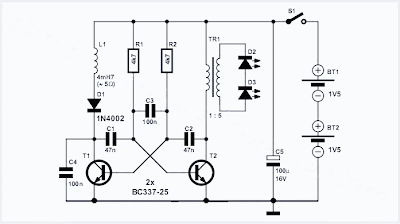The operating principle of the multivibrator has been well documented and with the components specified here it produces a square wave output with a frequency of around 800 Hz. This signal is used to drive a small transformer with its output across two LEDs connected in series. Conrad Electronics supplied the transformer used in the original circuit. The windings have a 1:5 ratio. The complete specification is available on the (German) company website at www.conrad.de part no. 516236. It isn’t essential to use the same transformer so any similar model with the same specification will be acceptable.
Unlike filament type light sources, white LEDs are manufactured with a built-in reflector that directs the light forward so an additional external reflector or lens glass is not required. The LEDs can be mounted so that both beams point at the same spot or they can be angled to give a wider area of illumination depending on your needs. Current consumption of the circuit is approximately 50 mA and the design is even capable of producing a useful light output when the battery voltage has fallen to 1 V. The circuit can be powered either by two AAA or AA size alkaline cells connected in series or alternatively with two rechargeable NiMH cells.
